The Smew, Mergellus albellus, is a small duck, which
is somewhat intermediate between the typical mergansers, genus
Mergus,
and the goldeneyes, Bucephala.
It is the only member of the genus Mergellus; sometimes
included in Mergus, this genus is distinct
(though closely related) and might actually be a bit closer
to the goldeneyes. The Smew has interbred with the Common
Goldeneye, Bucephala clangula.
The drake Smew, with its 'cracked ice' appearance, is unmistakable,
and looks very black-and-white in flight. The females and
immature males are grey birds with chestnut foreheads and crowns,
and can be confused at a distance with the Ruddy Duck;
they are often known as "redhead" Smew. It has oval
white wing-patches in flight. The Smew's bill has a hooked tip
and serrated
edges, which help it catch fish when it dives for them. |
 
Male
and female Smew.
http://en.wikipedia.org/wiki/File:Smew.both.arp.600pix.jpg |
This species breeds in the northern taiga of Europe and Asia.
It needs trees for breeding. The Smew lives on fish-rich lakes
and
slow rivers. As a migrant it leaves its breeding areas and winters
on sheltered coasts or inland lakes of the Baltic Sea,
the Black Sea, northern Germany and the Low Countries, with
small number reaching Great Britain (for example, at Dungeness),
mostly at regular sites. Vagrants have been recorded in North
America. On lakes it prefers areas around the edges, often under
small trees.
The Smew breeds in May and lays 6–9 cream-colored eggs.
It nests in tree holes, such as old woodpecker nests.
It is a shy bird and flushes easily when disturbed. |
Hooded Merganser,
Lophodytes cucullatus
 
The
Hooded Merganser, Lophodytes cucullatus, is a small
duck and is the only member of the genus Lophodytes.
left:. http://en.wikipedia.org/wiki/File:Hooded_merganser_-_female.jpg
right:. http://en.wikipedia.org/wiki/File:Kappens%C3%A4ger_m%C3%A4nnlich_seitlich_050501.jpg
|
The Hooded Merganser, Lophodytes cucullatus, is a small
duck and is the only member of the genus Lophodytes.
Hooded Mergansers have a crest at the back of the head which
can be expanded or contracted. In adult males, this crest has
a
large white patch, the head is black and the sides of the duck
are reddish-brown. The adult female has a reddish crest, with
much
of the rest of the head and body a greyish-brown. The Hooded
Merganser has a sawbill but is not classified as a typical merganser.
Hooded Mergansers are the second smallest species of merganser,
with only the Smew of Europe and Asia being smaller, and is
also the only Merganser whose native habitat is restricted to
North America.
Their preferred habitat for breeding is in swamps and wooded
ponds of the northern half of the United States and southern
Canada.
They prefer to nest in tree cavities near water, but will use
Wood Duck nesting boxes if available and unoccupied. They form
pairs
in early winter. The male leaves the female soon after she lays
her eggs, leaving her responsible for all incubation. After
hatching,
chicks leave the nest with their mother within 24 hours; they
are already able to dive and feed themselves, although they
remain
with their mother for another five weeks.
Hooded Mergansers are short-distance migrants, and winter in
the United States wherever winter temperatures allow for ice-free
conditions on ponds, lakes and rivers.
 Female
Hooded Merganser at Walsrode Bird Park, Germany.
Female
Hooded Merganser at Walsrode Bird Park, Germany.
The head is golden buff in the breeding season
http://en.wikipedia.org/wiki/File:Lophodytes_cucullatus_-Vogelpark_Walsrode_-female-8a.jpg
|
A few of these ducks have occurred as vagrants to Europe; however,
this attractive species is quite common in captivity,
and most birds seen in the wild in Europe are presumed to be
escapees.
These ducks feed by diving and swimming under water to collect
small fish, crustaceans and aquatic insects. They find their
prey
underwater by sight.
The hooded merganser is a sexually dimorphic species. The female
has a brown body, with a white underside and a light brown
crest extending from the back of the head. The male has a similar
appearance during nonbreeding season (although his eyes are
yellow while the female's are brown). During breeding season,
however, the male's plumage changes color: The head, back and
neck become black, with white stripes near the chest and tail,
and the bird develops a white crest on the back of the head
that can
be extended to attract mates.
First-winter birds differ from adult females, in having a grey-brown
neck and upperparts (black on adult females), and narrower
white tertial-edges than adults; all females are dark-eyed whereas
in first-winter males, a pale eye is acquired during the winter.
Source: http://en.wikipedia.org/wiki/Hooded_Merganser |
Brazilian
Merganser, Mergus octosetaceus
|
Red
List Category & Criteria: CR C2a(i) ver 3.1 (2001)
Year Assessed: 2006. Assessor/s: BirdLife International
Evaluator/s: Butchart, S. & Pilgrim, J. (BirdLife International
Red List Authority)
Justification: Recent records from Brazil, and particularly
a recent northerly range extension, indicate that this species's
status is better than previously thought. The remaining population
is still extremely small and severely fragmented, and the
perturbation and pollution of rivers continue to cause declines.
For these reasons, it is listed as Critically Endangered.
History: 1988 - Threatened (Collar and Andrew 1988)
1994 - Critically Endangered (Collar, Crosby and Stattersfield
1994)
2000 - Critically Endangered (BirdLife International 2000)
2004 - Critically Endangered (BirdLife International 2004)
IUCN 2008. 2008 IUCN Red List of Threatened Species. <www.iucnredlist.org>.
Downloaded on 11 April 2008.
|
The Brazilian Merganser
is one of the rarest birds in South America.
There may be less than 200 birds left.
One of the reasons for this scarcity are the strict habitat requirements
and the fact that suitable habitat is disappearing fast.
The Brazilian Merganser requires shallow, fast-flowing rivers with
rapids and clear waters
in which it catches fish by diving. These have to flow through areas
of forest, often surrounded by
cerrado, where the birds can build nests in tree cavities.
|
Cerrado
  Photo: ©
Carly Vynne
Photo: ©
Carly Vynne
|
The
Cerrado region of Brazil, comprising 21 percent of the country,
is the most extensive
woodland-savanna in South America. With a pronounced dry season,
it supports a unique
array of drought- and fire- adapted plant species and surprising
numbers of endemic bird species. Large mammals such as the
giant anteater, giant
armadillo, jaguar
and maned wolf also still
survive here but are competing with the rapid expansion of
Brazil's agricultural frontier,
which focuses primarily on soy and corn. Ranching is another
major threat to the region,
as it produces almost 40 million cattle a year.
http://www.biodiversityhotspots.org
|
The Brazilian Merganser
is one of the duller members of its genus
(compare, for example, the Red-breasted Merganser,
Mergus serrator).
It has a shiny dark green hood with a long crest, dark grey upperparts,
a white wing speculum,
a pale grey breast and bright orange-red legs. In flight the white
on the wings is very noticeable.
These three birds
are presumably a pair with a juvenile whose territory was on the
Rio São Francisco just downstream from the Casca d'Anta waterfall.
Each pair seems to
require several kilometres of river as territory so one wonders
how the offspring manage to find new territories given the scarcity
of habitat.
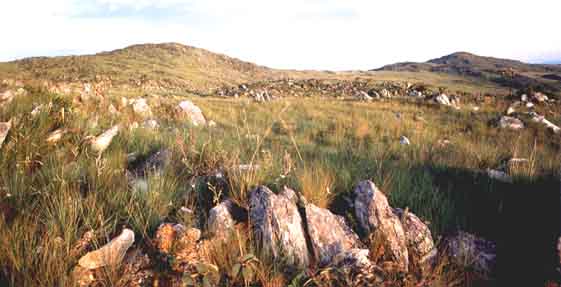 Chapadão
da Zagaia/Parque Nacional
Chapadão
da Zagaia/Parque Nacional
2001/2002 - 81 individuals estimated in a survey around Parque
Nacional da Serra da Canastra, Minas Gerais, Brazil
2002 -
The first record for ten years is made in Argentina in the
Uruzú river. Interviews with locals in Paraguay
indicate that the species may still exist there.
2007 -
A new breeding site is found in Goiás state, Brazil.
|
|
|
Scaly-sided
Merganser, Mergus
squamatus
 
Scaly-sided
Merganser,
male and female
http://en.wikipedia.org/wiki/File:261_Schuppens%C3%A4ger_20091229.JPG
http://en.wikipedia.org/wiki/File:253_Schuppens%C3%A4ger_2009123%C3%9F.JPG
|
The Scaly-sided Merganser or Chinese Merganser, Mergus
squamatus, is an endangered typical merganser, genus Mergus.
It lives in temperate East Asia, breeding in the north and wintering
in the south.
This striking sea duck has a thin red bill and a scaled dark
pattern on the flanks and rump. Both sexes have a crest of wispy
elongated feathers, reaching almost to the shoulders in adult
males and being fairly short in females and immatures. The adult
male
has a black head and neck, white breast and underparts, and
blackish mantle and wings, except for the white innerwings.
The scaling is also black, while the tail is medium grey. The
female has a buffish head and otherwise replaces the male's
black
with grey colour. The legs are orange-red and the irides dark
brown in both sexes.
Their breeding habitat is rivers in primary forest in the southeastern
Russian Far East, perhaps in North Korea, and in northeastern
China. The bulk of the species' population seems to breed in
the Xiao Xingangling Mountains (Heilongjiang Province) and
Changbai Mountains
of China. Mergus squamatus are migratory,
wintering in central and southern China, with small numbers
in
Japan, South Korea, Taiwan, northern Vietnam, Myanmar and Thailand.
They arrive on the breeding grounds as soon as winter
is over, in March, and leave when the first cold nights come
in late October.
This shy and easily startled bird favors mid-sized rivers which
meander through wide expanses of mixed forest in the lowlands,
up to 1,000 meters ASL or less. Birds tend to move upriver during
the day, both when startled and when foraging; the latter is
probably because stirred-up sediments will alert and hide prey
downstream. Food is caught with the serrated beak from among
the riverbed gravel. Often the birds dive for prey, repeatedly
submerging for a quarter-to half-minute with only a few seconds
pause between dives. In shallow water, the birds submerge only
the head; they do not upend. The birds are not very social,
and only rarely encountered in groups larger than pairs or families.
Even on the wintering grounds, groups of more than a dozen
are very rare.
 Various
stages of scaly-sided merganser chick development
Various
stages of scaly-sided merganser chick development
Video: Peiqi Liu, peiqil@126.com
Audio: Granada Wild and BBC Natural History Unit
www.arkive.org
|
They spend most of the daylight time foraging, except around
noon when they take some time to rest, preen and socialize at
the river banks, where they also sleep. The food of Mergus
squamatus consists of aquatic arthropods and small or young
fish.
Stonefly, Plecoptera, and Phryganeidae giant caddisfly
larvae may constitute the bulk of its diet when available. Beetles
and
crustaceans are eaten less regularly, though the latter may
be more important in autumn. As aquatic insect larvae hatch
in the course of the summer, fish become more prominent in the
diet. Favorite fish species include the Dojo Loach, Misgurnus
anguillicaudatus,
and the lenok Brachymystax lenok. More rarely eaten are
such species as the lamprey Eudontomyzon morii, the sculpin
Mesocottus haitej, or the Arctic Grayling, Thymallus
arcticus. Thus, they are opportunistic feeders; regarding
fish, they will probably eat any species that has the correct
elongated shape and small size.
Scaly-sided Mergansers nest in trees, as typical for the merganser
and goldeneye lineage of sea ducks. Preferred nesting trees
are
such species as Daimyo Oak, Quercus dentata, and Ussuri Poplar,
Populus ussuriensis, a balsam poplar.
They are sympatric with Mandarin Ducks,
Aix galericulata; though both relish the same insect
larvae, they do not seem to
compete for food, but perhaps for nesting holes (which neither
can excavate themselves). In its winter quarters, the Scaly-sided
Merganser might compete with other Merginae with which it shares
its habitat then, e.g. Common Mergansers,
Mergus merganser, and Common Goldeneyes, Bucephala
clangula. |
|
Red List Category & Criteria: Endangered
C2a(ii) ver 3.1
Year Assessed: 2009. Assessor/s BirdLife International
This species has a very small population which is suspected
to be undergoing a continuing and rapid decline as a result
of habitat loss, illegal hunting and disturbance.
It is therefore listed as Endangered.
History: 2008 – Endangered
2007 – 2002 Endangered
2000 – Vulnerable
1994 – Vulnerable
1988 – Threatened
|
In the 1960s and 1970s, its decline in Russia coincided with
economic development of the taiga. Primary forests in the valleys
of all large rivers were greatly altered, but large-scale deforestation
in river valleys is now prohibited, however the new Russian
Forest Codex (2007) requires a water protection zone (no deforestation)
of only 100 m for large rivers (50 m on each side),
and 50 m (25 m each side) for rivers shorter that 100 km, which
is likely to significantly reduce suitable breeding habitat
for the
merganser, which nests up to 150 m from the river. Logging of
river sources and adjacent slopes has led to reduced spring
water
levels and changes in fish abundance; since logging began on
the Avvakumovka River in 2004 spring water levels and merganser
populations have undergone continuous declines.
Other major threats within the breeding range include illegal
hunting, drowning in fishers' nets (a major cause of mortality
at
Russian breeding sites in 2003-2007), disturbance from motor
boats during the breeding season, river pollution and natural
predators. Increased hunting of waterfowl for sport together
with poor regulation of the spring hunting season (which is
intended
to coincide with passage migration
and avoid targeting locally breeding birds) is a significant
and increasing threat; large numbers
were reportedly shot in the Kievka River basin, southern Primorye,
in spring 2008.
Threats in its Chinese breeding range include dam construction,
deforestation, illegal hunting, human disturbance and the use
of
poisons and/or explosives for fishing4. Fine meshed nets were
a significant threat to the post-breeding congregations at Song
Jiang He in Jilin Province, China, but illegal fishing at the
site has been reduced and only large meshed nets are used in
legal fish-
farming. The site remains threatened by industrial pollution.
The proposed Korean Grand Canal project, which aims to canalise
3,134 km of the Korean peninsula's river and would radically
alter the Han and Nakdong rivers (which currently support an
estimated 30-50 birds in winter), was suspended in June 2008
but has not yet been cancelled.
BirdLife International
2009. Mergus squamatus. In: IUCN 2011. IUCN Red List of Threatened
Species. Version 2011.2.
<www.iucnredlist.org>. Downloaded on 20 April 2012. |
Auckland Islands Merganser,
Mergus australis

The
Auckland Islands Merganser, Mergus australis,
was a typical merganser which is now extinct.
© http://www.bbfish.net/pet/pet_6054.html
|
The Auckland Merganser or Auckland Islands Merganser, Mergus
australis, was a typical merganser which is now
extinct.
This duck was similar in size to the Red-breasted Merganser.
The adult male had a dark reddish-brown head, crest and neck,
with bluish black mantle and tail and slate grey wings. The
female was slightly smaller with a shorter crest.
This bird was first collected when a French expedition led
by the explorer Jules Dumont d'Urville on the ships L'Astrolabe
and
La Zelee visited the Auckland Islands in 1840. Its decline
was caused by a combination of hunting and predation by introduced
mammals. The bird was not flightless, but rather hard to flush;
it preferred to hide between rocks when pursued. The last
sighting
was of a pair shot on January 9, 1902. It was not found
in a 1909 search, and a thorough 1972/1973 exploration of
possible habitat concluded that it was long extinct.
|
|






 ©
Arthur Grosset
©
Arthur Grosset

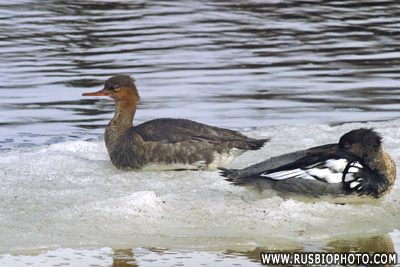
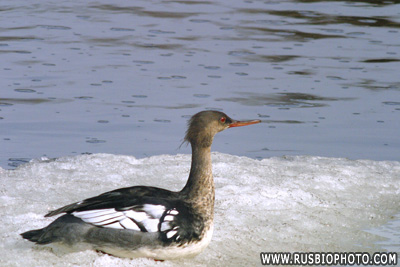
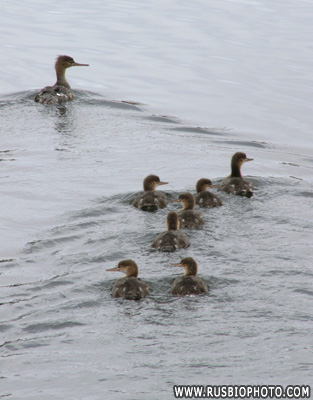
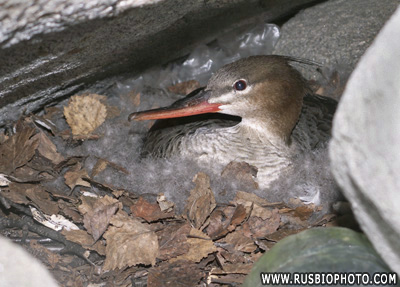
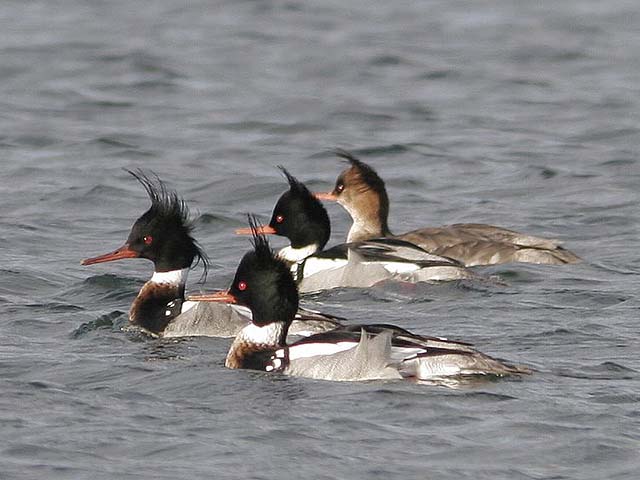
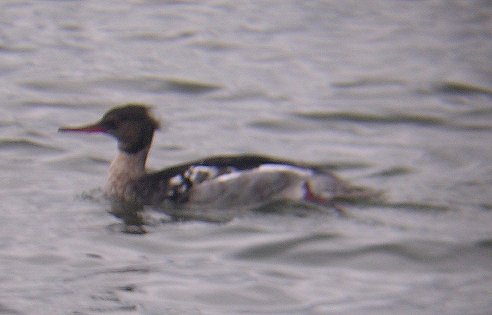




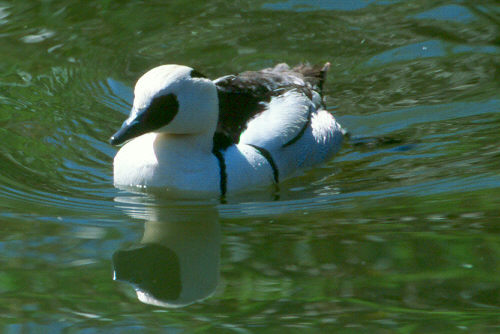





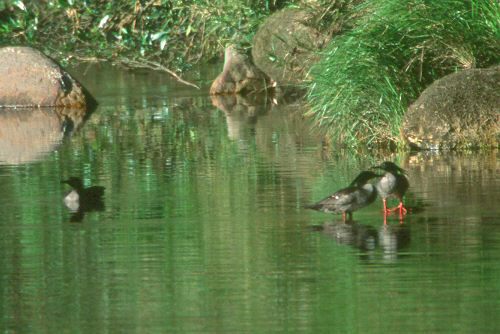


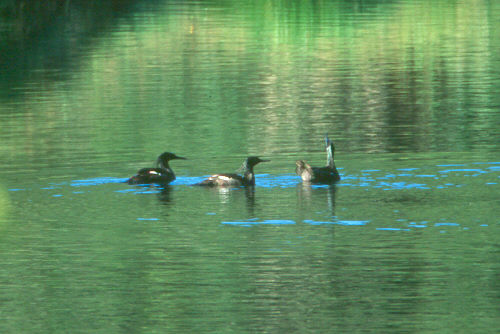
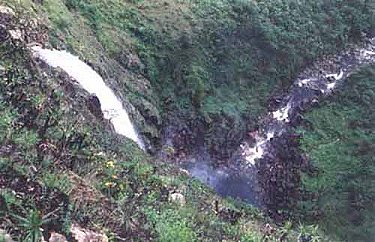
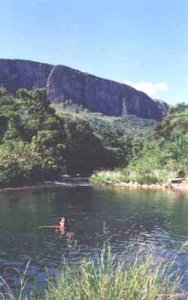

 From
the 'Rare Birds 2008'
From
the 'Rare Birds 2008' 






